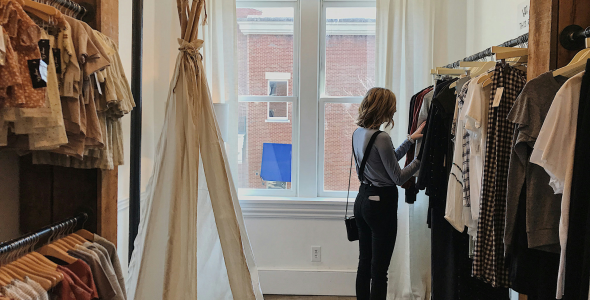How to optimise online shopping for senior citizens
More than half of senior citizens aged 65+ shop online. Compared with just one in five a decade ago. Here we explore how to optimise online shopping for the elderly.
Ecommerce for seniors: a growing trend
The use of digital products and services amongst senior citizens is on the rise as the internet plays an increasingly important role in commerce and other areas of life.
A huge 75% of adults over the age of 75 use the internet each day, with senior citizens now representing almost a third (28%) of all ecommerce purchases. In particular, women aged 75 and over represent one of the fastest growing demographics when it comes to internet usage.
People in their 60s are also the wealthiest demographic in the UK, and so present a significant and growing economic opportunity for brands looking to better cater to their needs.
As older generations grow, so does their knowledge of technology and the breadth of their online activities. But our aging population also means that more people are becoming disabled in later life, with internet use amongst disabled adults also on the rise.
Reaching senior citizen customers therefore requires renewed focus on designing inclusively to ensure you’re addressing the needs of your older customers.
How to improve online shopping for the elderly
There are financial and moral drivers for making your ecommerce experiences more accessible to older shoppers.
There’s a third benefit too, because while digital accessibility is essential for older shoppers, it’s useful for all your customers alike (learn more about the usability benefits of accessibility).
Retailers that want to tap into the economic power of this demographic need to improve usability at every touchpoint. And adjust the buying experience to cater to these shoppers.
So how can online retailers deliver a compelling proposition and ecommerce experience to senior citizens?
- Start with user research to identify whether your product and proposition is right for older demographics. Are your ‘older shopper’ edge cases actually edge cases? Or is it just that you aren’t catering to them. What’s their perception of value and does your product or service provide it to them?
- Use usability testing and prototyping to understand how those demographics expect to engage with your product, and whether you need to adapt your product to cater to them. You might need a totally different user journey across different demographics, or you might just need to brand things differently (think about the ways a similar gambling product can be repackaged to suit a day-time TV audience versus a prime-time, male-dominated sports audience).
Building prototypes of potential user journeys, functionality, and interfaces allows you to gain fast feedback from real users, without investing in building a product that may not suit their needs.
- Hand control back to your customers, designing pages in ways that allow users to customise their experience (changing text size or magnification, for example), and cater to the differing ways people may be trying to engage with your site to ensure you’re not excluding potential customers. Ensure you’re using significant colour contrasts that meet web accessibility guidelines, and simplify forms with the likes of address lookup, autocomplete, and autocorrect.
- Be transparent and informative. Provide upfront information about tax and shipping, along with important information about products. Use a product information management (PIM) solution like Akeneo to ensure your product information is complete, accurate, and tailored to your market. Use video and rich imagery to allow shoppers to make an informed purchase decision that brings items to life.
Understand the challenges, aspirations, and emotions of your customer, and what information they need to progress in their engagement with you.
- Consider the end-to-end experience. Today’s senior shoppers grew up in an offline world with a more ‘human’, face-to-face approach to customer service. This should be a careful consideration as you look at how to reduce friction points in the end-to-end user journey. Things that might feel like ‘value adds’ may actually be essential for older customers – think webchats for customers who are hard of hearing, delivery and assembly options for heavy items, and advanced notifications of who will be delivering an order and when to prevent unannounced callers.
How retailers can build trust with senior citizens
Online retailers grow customer lifetime value when they focus on how to build trust and loyalty.
A simple way to build trust is to offer payment tools that older shoppers know and trust.
Trust is especially important for older shoppers, as newer users of the internet.
Show that you support established payment providers like PayPal – rather than solely pushing alternatives that target younger shoppers.
Only 22% of the 65+ population uses mobile wallets, for example.
Ecommerce for seniors: test and iterate
As a growing demographic, senior citizens will have a significant impact on your ecommerce business in the coming years.
What’s more, with 23% of people aged 70+ feeling ‘shut out’ from the high street, ecommerce brands have a clear opportunity to improve online shopping for the elderly.
Take action today to ensure you provide a great customer experience to all your potential customers, whatever their age or access needs.
The key thing here is to research, prototype, user test, enhance your digital product. And then continue to review and optimise it.
Be sure to also check out these web accessibility examples for inspiration. And learn how to do an accessibility audit to make your site more accessible.
About the author
Brett helps clients resolve complex business challenges, develop their strategies, expand their digital propositions, and ensure ROI.
He has 22 years’ experience in retail and digital, working for leading international brands in commercial, operational, and technical roles.
Highlights include Global Head of IT for a £1 billion international visitor attraction operator. And Head of Ecommerce at a major online retailer, where Brett was accountable for growth and end-to-end business operations.





